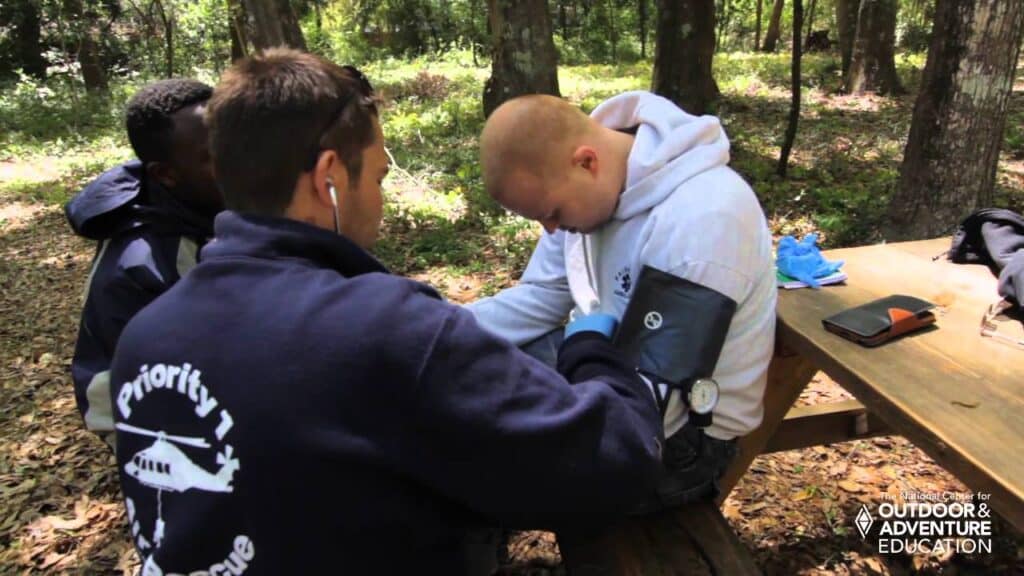Emergency medical technicians (EMTs) play a vital role in the modern healthcare system, providing immediate, life-saving assistance to people experiencing acute medical conditions or traumatic injuries. By rapidly assessing and treating patients in critical situations, EMTs improve survival rates, minimize complications, and optimize treatment outcomes.

Training, testing, and certification ensure all EMTs have the skills needed to respond to life-threatening emergencies. In this post, we explore the history of EMT training and certification, bring you up to speed on its current state, and look ahead to its future. Why this matters to us here at The National Center for Outdoor & Adventure Education (NCOAE) is because we offer such training for EMTs throughout the U.S.
The Evolution of EMT Testing: Past to Present
EMT testing and certification have evolved over the course of nearly six decades. Formalized training didn’t begin until the late 1960s. It was initiated by the publication of a white paper in 1966 titled, “Accidental Death and Disability: The Neglected Disease of Modern Society.” The paper was in response to increasing trauma and death resulting from traffic accidents in the United States.
Up to that time, ambulance services generally consisted of team members with little to no formal training, with such services often relying on volunteers. And any formalized training and testing that was being done was administered locally by individual states. This resulted in a patchwork of standards and requirements along with inconsistencies in skill sets across regions.
The creation of the first EMT training programs in the late 1960s led to the development of a more formal approach. The National Registry of Emergency Medical Technicians (NREMT) was established in 1970 to develop comprehensive testing and certification protocols and to establish a national standard. Its goal was to ensure that EMTs have the necessary skills and knowledge to provide high-quality care in emergency situations.
Initially, only a few states required NREMT certification, and many continued to rely on state-level exams.
The Current State of EMT Testing
Today, most states use the National Registry of Emergency Medical Technicians (NREMT) as the standard for certification. The NREMT exam is broken down into two parts:
- Cognitive Exam: A computer-based test that evaluates knowledge across topics such as airway management, trauma, medical emergencies, and operations.
- Psychomotor Exam: Hands-on testing that requires candidates to demonstrate practical skills, such as patient assessment and emergency interventions.
Some states require additional state-specific exams or continue offering their own test options in parallel to the NREMT.
Admittedly, the NREMT exam is not the perfect solution for assessing EMT knowledge, skills, and readiness, but it is the most comprehensive assessment tool currently in circulation. Critics focus mostly on the following two shortcomings:
- High failure rates on the first attempt, especially in the cognitive section.
- Uncertainty over whether the test adequately measures real-world readiness.
Despite its shortcomings, having more formalized training and testing has not only improved patient outcomes but also helped to establish emergency medicine as a profession that serves a vital role in modern healthcare systems around the world.
Looking Toward the Future of EMT Testing and Certification
EMS testing is gradually moving away from traditional methods that prioritize memorization of algorithms and protocols. Instead, there is a growing emphasis on evaluating students’ critical thinking, judgment, and decision-making skills in real-world scenarios.
This shift reflects the evolving nature of emergency medical care, where first responders must adapt quickly to dynamic situations. Testing now focuses on students’ ability to assess and respond to complex patient needs, encouraging them to apply foundational knowledge with flexibility and critical reasoning, rather than simply recalling predefined steps.
Exploring Trends and Innovations in EMT Testing
The introduction of the NREMT exam may have established a national standard for emergency medical care, but it did not lock it down. The EMT profession, as well as the training and certification part of it, continue to evolve. These are some of the trends we are tracking:
- Shift towards technology-enhanced testing: Virtual reality (VR) simulations and augmented reality (AR) tools may soon supplement traditional hands-on exams, offering testing of EMT candidates in immersive, real-world scenarios.
- Standardization across all states: There’s a push toward making the NREMT the singular national standard, with fewer state-specific deviations.
- Increased focus on continuing education: Future testing may emphasize ongoing assessments throughout an EMT’s career, not just during initial certification.
- Adapting to changes in medicine and emergency response: As new medical technologies and protocols emerge, future EMT testing will need to evolve to ensure that EMTs remain prepared for contemporary emergency care challenges.
Testing and certification must continue to evolve to meet the demands of modern emergency medicine and improvements in protocols, techniques, equipment, and technologies. Providing a more standardized, accessible, and realistic testing process will better prepare EMTs for the challenges they face in the field while improving patient outcomes.
– – – – – – –
About the Author: Todd Mullenix is the Director of Wilderness Medicine Education at The National Center for Outdoor & Adventure Education in Wilmington, North Carolina.
TALK TO US
Have any further questions about our courses, what you’ll learn, or what else to expect? Contact us, we’re here to help!
Leave a comment